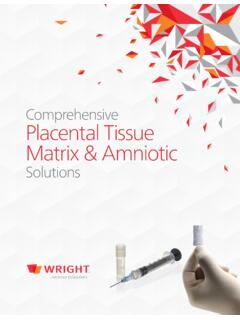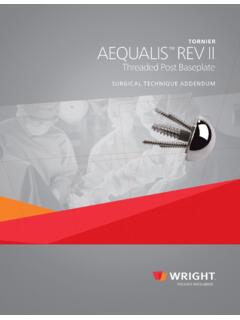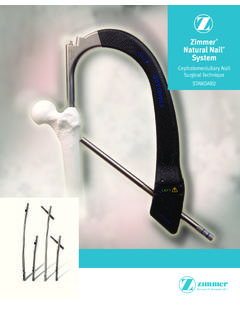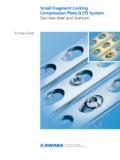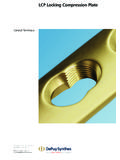Transcription of TORNIER AEQUALIS REVERSED FX - eMedia - …
1 TORNIERAEQUALIS REVERSED FXShoulder SystemSURGICAL TECHNIQUE2 Table of Contents: 3 Implant Description ..4 Implant ..6 Indications and Contraindications ..6 surgical technique ..7 Preoperative Planning ..7 Patient Positioning ..7 surgical Approach ..8 Fracture Exposure ..8 Glenoid Exposure and Preparation ..9 Preparation Of The Humerus ..10 Humeral Reaming ..10 Drilling of Diaphyseal Sutures Holes ..10 Positioning of the Trial Stem ..11 Placing the Bone Graft ..12 Cementing the Implant ..13 Placement of Final Humeral Implant ..13 Impaction of Humeral Insert ..14 Reduction of Implant ..14 Tuberosity Fixation ..15 Trial and Closure ..17 Rehabilitation ..18 Complications ..19 AEQUALIS REVERSED Non REVERSED Hemi-Prosthesis Adaptor technique ..20 Preparation of Metaphyseal Implant ..21 Affixing Union Screw ..21 Implantation of Adaptor ..21 Impaction of Humeral Head ..21 Assembly of Prosthesis Holder.
2 22 Prosthesis Holder Components ..22 Assembly of Height Gauge ..23 Assembly of Prosthesis Holder ..23 Assembly of Retroversion Rod ..23 Color Coding ..24 Instrumentation ..26 Implants ..284 Monobloc Stem and Metaphysis Eliminates the risk of disassociation. 12 sizes accommodate varying anatomy, including revision MetaphysisDistal Grooved StemSingle Metaphysis DiameterSame cup diameter is used for the two articular diameters of 36 mm and 42 WindowOpen neck for bone graftingPolished NeckAccommodates AEQUALIS suture technique and reduces risk of suture Description5 Lateralized SpacerOptional 9 mm spacer allows an increase in lateralization and height. Used with a polyethylene insert, this spacer can increase the thickness to 15, 18 or 21 mm to increase deltoid and 42 mm dia. Polyethylene InsertsAllows optimal deltoid tension and implant stability while avoiding risk of acromial impingement.
3 Both centered and constrained insert options are available in 6, 9 and 12 mm Designed for Tuberosity Reduction, Fixation and Healing6 Indications and ContraindicationsThe AEQUALIS REVERSED Fracture Shoulder Prosthesis is indicated for patients with a functional deltoid muscle as a total shoulder replacement for the relief of pain or significant disability following arthropathy associated to a grossly deficient rotator cuff joint: In case of traumatic or pathologic conditions of the shoulder resulting in fracture of the glenohumeral joint, including humeral head fracture and displaced 3-or 4-part proximal humeral fractures, or In case of bone defect in the proximal humerus. The AEQUALIS REVERSED Fracture Shoulder Prosthesis is also indicated for prosthetic revisions with a grossly deficient rotator cuff joint when other treatments or devices have AEQUALIS REVERSED Fracture Shoulder humeral stem is used in association with the glenoid components of the AEQUALIS REVERSED Shoulder AEQUALIS REVERSED Fracture Shoulder humeral stem is for cemented use only.
4 A complete list of contraindications can be found in the Instructions For Use packaged with the Description7 Preoperative Planning Thorough patient evaluation with history and physical examination is advised. Evaluation of the contralateral shoulder should be done since there can be limited range of rotation with a REVERSED prosthesis. The deltoid muscle must be evaluated by clinical examination. Weakness of the deltoid does not constitute a strict contraindication to a REVERSED fracture prosthesis. The preoperative studies should include computed tomographic (CT) scan to classify the fracture, determine the displacement and status of the tuberosities, evaluate indirectly the status of the rotator cuff by analysis of fatty infiltration of the muscles and assess the glenoid bone X-rays of the whole humerus allow evaluation of bone loss in comminuted fractures and help the surgeon estimate the approximate stem height of the prosthesis by comparing measurements of the contralateral side of the humerus with measurements of the fractured Positioning Patient is placed in a beach chair position with the shoulder off the patient is vertically inclined to the angle determined according to the surgical approach TechniqueSurgical Technique8 surgical ApproachThe superolateral approach is usually recommended for these is placed in a beach chair position.
5 A longitudinal incision is made, starting from the acromio-clavicular ligament and running distally for 4 cm following the anterior edge of the acromion. The anterior and middle deltoid muscles are separated with respect to the lateral edge of the acromion. It is important to be careful with the dissection to avoid an axillary nerve injury since this nerve is found about 4 cm away on the lateral side of the acromion. (Figure 1)The deltopectoral approach can also be Exposure The first step is to identify the fracture fragments. (Figure 2)Once the fragments have been identified, the supraspinatus tendon is resected to the glenoid humeral head fragment is removed and a tenotomy of the long head of the biceps is done. The intra-articular portion is then ligament will be tenodesed with suture to the transverse ligament before greater tuberosity is mobilized posteriorly and four mattress sutures (green and rose colored) are placed from outside to inside by means of a crimping suture needle.
6 (Figure 3)The lesser tuberosity is identified anteriorly and a suture is placed through the subscapularis tendon to facilitate its manipulation at the time of fixation of the tuberosities. (Figure 3, gray suture) The lesser tuberosity is retracted anteriorly for glenoid 1 Figure 2 Figure 39 Glenoid Exposure And PreparationThe characteristics of the fracture usually allow easy exposure of the glenoid (Figure 4).The various surgical steps for exposure and implantation of the baseplate and glenoid sphere are described in the surgical technique of AEQUALIS REVERSED (UDRT and UDXT) : Figure 4 Note: Instability is a considerable risk when a REVERSED prosthesis is used for fracture as a result of:- Deltoid atony. - Lack of reliable anatomic landmarks. To avoid instability: - Inferiorly position the base Position the humeral implant to the correct height using the greater tuberosity as a The prosthesis should not be implanted lower than the superior edge of the greater The greater tuberosity must be reduced with the arm in neutral PREPARATION OF THE HU-MERUSH umeral ReamingThe medullary canal of the humeral shaft is progressively reamed with reamers of increasing diameter (7, 9, 11, 13, 15 mm) until the reamer contacts the cortical bone.
7 (Figure 5)The last reamer used determines the size of the humeral diameter corresponds to a color code that easily identifies which instrument to use. (Figure 6) The reamers are marked at depths that correspond to the necessary reaming length according to the chosen of Diaphyseal Sutures HolesTwo holes are drilled laterally in the bicipital groove 2 cm under the fracture site. Two nonabsorbable sutures are passed from outside to inside and then from inside to outside. (Figure 7)Figure 5 Figure 6 Figure 7 Preparation of the HumerusNote: In case of revision, it is important to remove as much cement residue as possible to not interfere with tuberosity the Trial StemRetroversionThe trial stem is introduced in the medullary the retroversion with the retroversion rod. It has to be parallel to the patient s forearm. The guide retroversion is adjusted to 20 relative to epicondyles (25 in relation to the forearm).
8 The second retroversion rod can be used as an orthogonal landmark by placing it on the mark is made with electrocautery at the lateral fin of the stem and will be used as a landmark to position the definitive implant. (Figure 8 - Zoom 1)Figure 8 Zoom 1 Zoom 2 Note: The assembly of the guide is detailed pages 10 Figure 11 Figure 12 Figure 9 Selecting HeightTo select the proper height, place the superior aspect of the trial implant to the superior edge of the reduced greater tuberosity (Figure 9)Inspect the reduction of the greater tuberosity for confirmation of proper positioning of the with the trial implant can be done once the prosthesis holder is prosthesis must be stable upon insertion before the tuberosities can be the stem sits too low, insert the next larger the appropriate height has been achieved, position the height gauge on an anatomic landmark. The height is then read on the ruler (Figure 8 - Zoom 2).
9 This reference will be used again when the final implant is the Bone GraftBone grafting is recommended to enhance consolidation of the tuberosities. Two bone grafts are harvested from the humeral head in the bone graft cutter. In case of revision, or if the bone quality of the humeral head is not sufficient, autografts or allografts can be to cutting the graft, ensure that the thumb screw is unscrewed. Position the humeral head in the bone graft cutter. (Figure 10)The graft is cut by firmly tightening the the case of exceptionally hard bone, a mallet can be used to strike the dural part of the harvested graft is cut with a gouge-forceps before it is removed. (Figure 11)Tighten the thumb screw to remove the graft. (Figure 12)13 Once cut, the graft is placed in the window of the final prosthesis before it is placed in the humerus. (Figure 13)Cementing the ImplantAfter placing the diaphyseal plug, the humeral canal is dried and cement is injected using a large syringe.
10 If desired, a surgical drain can be temporarily placed in the medullary cavity. (Figure 14)Placement of Final Humeral ImplantInsert the final prosthesis using the prosthesis the height to the same level as defined during the trial retroversion by aligning the lateral fin of the prosthesis with the previously made mark. This is then confirmed using the retroversion rod attached to the prosthesis holder. (Figure 15)Excess cement is removed with a 13 Figure 14 Figure 1514 Impaction of Humeral InsertAfter the cement is dry, the selected polyethylene insert is positioned by aligning the insert s orientation notch with the metaphyseal with different sizes of trial humeral inserts can be performed to optimize muscular stability. Once the final thickness is selected, the according to the Rev II surgical technique addendum (CAW-6087).Insert a metaphyseal plug and screw it into the base of the final insert is impacted into the metaphysis (Figure 16a-b-c) according to the Rev II surgical technique addendum (CAW-6087).


